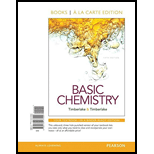
Concept explainers
(a)
Interpretation:
Interpret the resonance structures for HCO3- with C atom and H atom linked to O atom.
Concept Introduction:
Resonance is the term which indicates about the equivalency in the structure obtained after shifting of the double bond in the chain. The shifting of double bonds takes place due to the transferring or flow of electrons in it. This is only possible if there are conjugated double bond or a double bond and negative charge.
(b)
Interpretation:
Interpret the shape of bicarbonate ion around C atom.
Concept Introduction:
The shape of a molecule can be determined with the help of VSEPR model in which lewis structure of the molecule is drawn which shows the arrangement of surrounding atoms around the central atom.
The shape of molecule is decided by counting the lone pair of electrons along with bond pair and thus the shape of molecule is decided. Shape of molecule can be decided as:
| Bond pair | Lone pair | Geometry of molecule |
| 2 | 0 | Linear |
| 3 | 0 | Trigonal planar |
| 2 | 1 | Bent |
| 4 | 0 | Tetrahedral |
| 3 | 1 | Trigonal pyramidal |
| 2 | 2 | Bent |
| 5 | 0 | Trigonal bipyramidal |
| 4 | 1 | See saw |
| 3 | 2 | T shaped |
| 2 | 3 | Linear |
| 6 | 0 | Octahedral |
| 4 | 2 | Square planar |
Want to see the full answer?
Check out a sample textbook solution
Chapter 10 Solutions
Basic Chemistry, Books a la Carte Edition (5th Edition)
 ChemistryChemistryISBN:9781305957404Author:Steven S. Zumdahl, Susan A. Zumdahl, Donald J. DeCostePublisher:Cengage Learning
ChemistryChemistryISBN:9781305957404Author:Steven S. Zumdahl, Susan A. Zumdahl, Donald J. DeCostePublisher:Cengage Learning ChemistryChemistryISBN:9781259911156Author:Raymond Chang Dr., Jason Overby ProfessorPublisher:McGraw-Hill Education
ChemistryChemistryISBN:9781259911156Author:Raymond Chang Dr., Jason Overby ProfessorPublisher:McGraw-Hill Education Principles of Instrumental AnalysisChemistryISBN:9781305577213Author:Douglas A. Skoog, F. James Holler, Stanley R. CrouchPublisher:Cengage Learning
Principles of Instrumental AnalysisChemistryISBN:9781305577213Author:Douglas A. Skoog, F. James Holler, Stanley R. CrouchPublisher:Cengage Learning Organic ChemistryChemistryISBN:9780078021558Author:Janice Gorzynski Smith Dr.Publisher:McGraw-Hill Education
Organic ChemistryChemistryISBN:9780078021558Author:Janice Gorzynski Smith Dr.Publisher:McGraw-Hill Education Chemistry: Principles and ReactionsChemistryISBN:9781305079373Author:William L. Masterton, Cecile N. HurleyPublisher:Cengage Learning
Chemistry: Principles and ReactionsChemistryISBN:9781305079373Author:William L. Masterton, Cecile N. HurleyPublisher:Cengage Learning Elementary Principles of Chemical Processes, Bind...ChemistryISBN:9781118431221Author:Richard M. Felder, Ronald W. Rousseau, Lisa G. BullardPublisher:WILEY
Elementary Principles of Chemical Processes, Bind...ChemistryISBN:9781118431221Author:Richard M. Felder, Ronald W. Rousseau, Lisa G. BullardPublisher:WILEY





